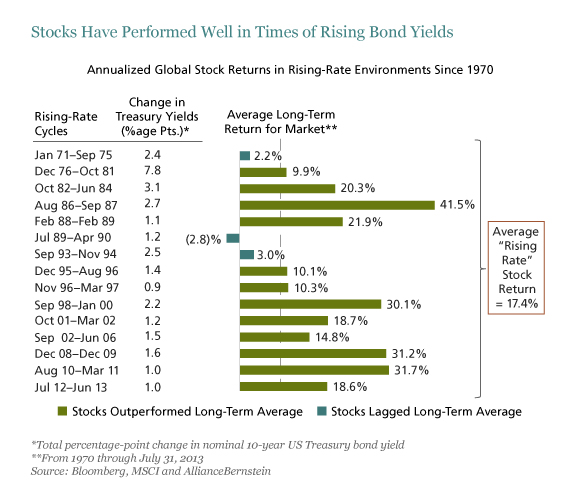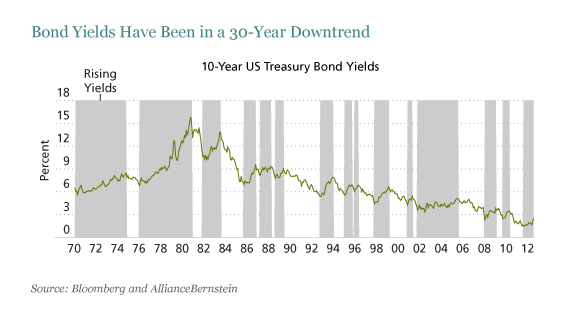Stocks have generally performed very well in rising-rate environments. But the current rate cycle is unlike any other of the past 40 years, keeping investors on edge. A lot will depend on how inflation behaves.
Though we are in uncharted territory, history can still provide important clues about what may lie ahead. We studied global stock performance during the 15 bouts of rising 10-year US Treasury bond yields since 1970. We found that, on average, stocks tallied annualized gains of around 17% during these periods, outperforming their long-term average pace by roughly eight percentage points (Display 1).

The hitch here is that, for the past 30 years, these rising-yield episodes have been short-lived blips within a steady downtrend. Each uptick was followed by a downturn, often to lower lows (Display 2). In most cases, bond yields rose as the Fed moved to clamp down on incipient inflationary pressures—but not so much that it damaged corporate profitability. The backdrop is very different today, with the US economic recovery still fragile and inflation flatlining.

But rising bond yields haven’t always been good for stocks, and the reasons behind this are instructive. This is particularly true for two of the three outliers: the early 1970s, which coincided with a persistent surge in inflation and stagnating GDP growth, and the Great Bond Massacre of 1993–1994, when strong real GDP growth fed production-related price pressures. In both periods, inflation trends provoked aggressive Fed intervention. Stocks appreciated in both cases, but significantly lagged versus their average historical gains.
The 1970s were marked by two massive back-to-back inflation spikes. Amid a booming economy and the 1973 OPEC oil embargo, the Consumer Price Index (CPI) more than tripled, to 12%, between 1971 and 1974, before falling by half the next year. Global stocks rose an annualized 2.2% during that period, significantly trailing their historical average pace of 9%, as well as inflation. Most of that underperformance came in the last two years, as stagflation set in.
Soaring energy prices and strong wage growth fueled another spike from 1977 through 1980, with the CPI reaching 15% before the Fed’s “scorched earth” tightening campaign and the ensuing recession brought inflation under control. Interestingly, stocks did much better during this period—scoring a modestly above-average annualized gain of nearly 10%. Most of this outperformance occurred during the 1980–1981 bull market, as inflation and bond yields fell.
So what does history tell us? Context matters in how stocks perform in rising-rate environments, with inflation a key variable. We believe that, if bond yields rise in response to a stronger economy, but inflation expectations remain well anchored, stocks should do well as companies benefit from improving demand and pricing power. But if we get stagflation, as in the mid-1970s, then all bets are off.
With the economy still trying to gain traction, Fed tightening appears a long way off. Our economics and fixed-income investment teams anticipate a measured and gradual normalization of US monetary policy as the economy heals, and a commensurate rise in US bond yields from today’s exceptionally low levels. On that basis, we think the prognosis for stocks looks good.
The views expressed herein do not constitute research, investment advice or trade recommendations and do not necessarily represent the views of all AllianceBernstein portfolio-management teams.